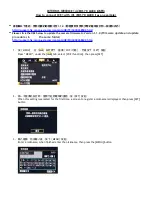
AAM6010EV-M ADSL Combo Router User’s Manual
data between your ISP and your computer. The WAN interface on the
AAM6000EV-M uses two forms of PPP called PPPoA and PPPoE.
See also
PPPoA, PPPoE
.
PPPoE
Point-to-Point Protocol over Ethernet
One of the two types of PPP interfaces you can define for a Virtual Circuit (VC),
the other type being PPPoA. You can define one or more PPPoE interfaces per
VC.
protocol
A set of rules governing the transmission of data. In order for a data transmission to
work, both ends of the connection have to follow the rules of the protocol.
remote
In a physically separate location. For example, an employee away on travel who
logs in to the company’s intranet is a remote user.
RIP
Routing Information Protocol
The original TCP/IP routing protocol. There are two versions of RIP: version I and
version II.
RJ-11
Registered Jack Standard-11
The standard plug used to connect telephones, fax machines, modems, etc. to a
telephone jack. It is a 6-pin connector usually containing four wires.
RJ-45
Registered Jack Standard-45
The 8-pin plug used in transmitting data over phone lines. Ethernet cabling usually
uses this type of connector.
routing
Forwarding data between your network and the Internet on the most efficient route,
based on the data’s destination IP address and current network conditions. A
device that performs routing is called a router.
rule
See filtering rule, NAT rule
.
SDNS
Secondary Domain Name System (server)
A DNS server that can be used if the primary DSN server is not available.
See
DNS
.
SNMP
Simple Network Management Protocol
The TCP/IP protocol used for network management.
subnet
A subnet is a portion of a network. The subnet is distinguished from the larger
network by a
subnet mask
which selects some of the computers of the network
and excludes all others. The subnet's computers remain physically connected to
the rest of the parent network, but they are treated as though they were on a
separate network.
See also network mask
.
subnet mask
A mask that defines a subnet.
See also network mask
.
TCP
See TCP/IP
.
TCP/IP
Transmission Control Protocol/Internet Protocol
The basic protocols used on the Internet. TCP is responsible for dividing data up
into packets for delivery and reassembling them at the destination, while IP is
responsible for delivering the packets from source to destination. When TCP and
IP are bundled with higher-level applications such as HTTP, FTP, Telnet, etc.,
TCP/IP refers to this whole suite of protocols.
Telnet
An interactive, character-based program used to access a remote computer. While
HTTP (the web protocol) and FTP only allow you to download files from a remote
computer, Telnet allows you to log into and use a computer from a remote location.
TFTP
Trivial File Transfer Protocol
A protocol for file transfers, TFTP is easier to use than File Transfer Protocol (FTP)
but not as capable or secure.
TTL
Time To Live
A field in an IP packet that limits the life span of that packet. Originally meant as a
time duration, the TTL is usually represented instead as a maximum hop count;


































